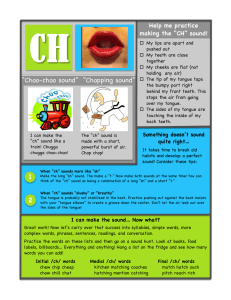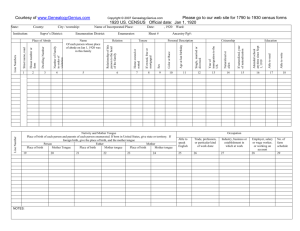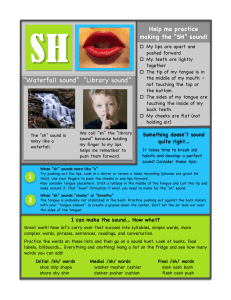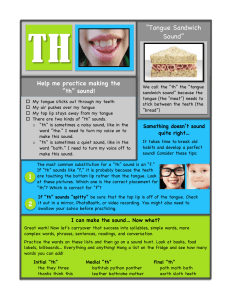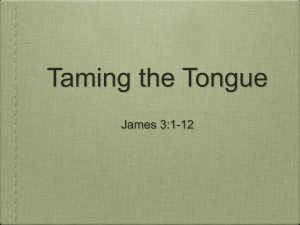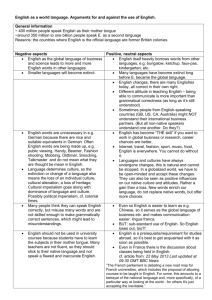Document 12929275
advertisement
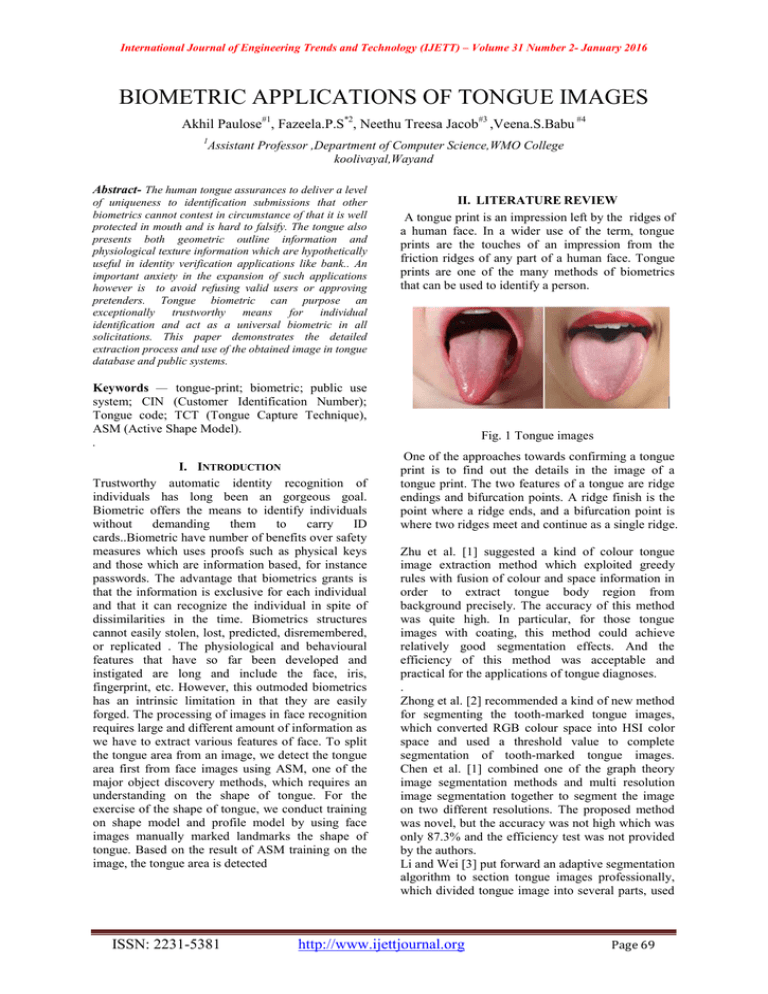
International Journal of Engineering Trends and Technology (IJETT) – Volume 31 Number 2- January 2016 BIOMETRIC APPLICATIONS OF TONGUE IMAGES Akhil Paulose#1, Fazeela.P.S*2, Neethu Treesa Jacob#3 ,Veena.S.Babu #4 1 Assistant Professor ,Department of Computer Science,WMO College koolivayal,Wayand Abstract- The human tongue assurances to deliver a level of uniqueness to identification submissions that other biometrics cannot contest in circumstance of that it is well protected in mouth and is hard to falsify. The tongue also presents both geometric outline information and physiological texture information which are hypothetically useful in identity verification applications like bank.. An important anxiety in the expansion of such applications however is to avoid refusing valid users or approving pretenders. Tongue biometric can purpose an exceptionally trustworthy means for individual identification and act as a universal biometric in all solicitations. This paper demonstrates the detailed extraction process and use of the obtained image in tongue database and public systems. II. LITERATURE REVIEW A tongue print is an impression left by the ridges of a human face. In a wider use of the term, tongue prints are the touches of an impression from the friction ridges of any part of a human face. Tongue prints are one of the many methods of biometrics that can be used to identify a person. Keywords — tongue-print; biometric; public use system; CIN (Customer Identification Number); Tongue code; TCT (Tongue Capture Technique), ASM (Active Shape Model). . I. INTRODUCTION Trustworthy automatic identity recognition of individuals has long been an gorgeous goal. Biometric offers the means to identify individuals without demanding them to carry ID cards..Biometric have number of benefits over safety measures which uses proofs such as physical keys and those which are information based, for instance passwords. The advantage that biometrics grants is that the information is exclusive for each individual and that it can recognize the individual in spite of dissimilarities in the time. Biometrics structures cannot easily stolen, lost, predicted, disremembered, or replicated . The physiological and behavioural features that have so far been developed and instigated are long and include the face, iris, fingerprint, etc. However, this outmoded biometrics has an intrinsic limitation in that they are easily forged. The processing of images in face recognition requires large and different amount of information as we have to extract various features of face. To split the tongue area from an image, we detect the tongue area first from face images using ASM, one of the major object discovery methods, which requires an understanding on the shape of tongue. For the exercise of the shape of tongue, we conduct training on shape model and profile model by using face images manually marked landmarks the shape of tongue. Based on the result of ASM training on the image, the tongue area is detected ISSN: 2231-5381 Fig. 1 Tongue images One of the approaches towards confirming a tongue print is to find out the details in the image of a tongue print. The two features of a tongue are ridge endings and bifurcation points. A ridge finish is the point where a ridge ends, and a bifurcation point is where two ridges meet and continue as a single ridge. Zhu et al. [1] suggested a kind of colour tongue image extraction method which exploited greedy rules with fusion of colour and space information in order to extract tongue body region from background precisely. The accuracy of this method was quite high. In particular, for those tongue images with coating, this method could achieve relatively good segmentation effects. And the efficiency of this method was acceptable and practical for the applications of tongue diagnoses. . Zhong et al. [2] recommended a kind of new method for segmenting the tooth-marked tongue images, which converted RGB colour space into HSI color space and used a threshold value to complete segmentation of tooth-marked tongue images. Chen et al. [1] combined one of the graph theory image segmentation methods and multi resolution image segmentation together to segment the image on two different resolutions. The proposed method was novel, but the accuracy was not high which was only 87.3% and the efficiency test was not provided by the authors. Li and Wei [3] put forward an adaptive segmentation algorithm to section tongue images professionally, which divided tongue image into several parts, used http://www.ijettjournal.org Page 69 International Journal of Engineering Trends and Technology (IJETT) – Volume 31 Number 2- January 2016 an iterative approach to calculate each threshold, and used each local threshold to segment tongue images. The experimental results showed that the algorithm could section well the tongue images whose background and boundaries were not strong. But only 2 models which were a tongue image with emaciated coating and a tongue image with white coating were processed and the effectiveness of this method was not proved by the incomplete number of samples. III. PROPOSED METHOD A. Techniques for capturing tongue images. For seizing tongue images we capture anterior views of tongue. For capturing the tongue image we use a TCT system. This system has many components. Head placement area-it is the place where user has to place his head for taking tongue images. Digital camera employed take frontal view. Laser systemfinds the correct pose with assistance of the laser locator. Platform-a processing platform having the computers and software. The tongue image data is captured with the imaging system (TCT). Each person is educated to sit in front of the tongue image capture system. They are requested to stick out his\her tongue downwards. The sampling process requires subjects to stick out their tongue in a standard way: the tongue should be flat to enable the tongue to be measured accurately and tongue must not be bent overly, as this will B. Extraction of tongue image from face using ASM The application of ASM is shown in the figure. To divide the tongue area from an image, we detect the tongue zone first from face imageries using ASM, one of the major entity detection methods. For the training of the shape of tongue, we train on shape model and profile model by using face images manually. In the study Adaboost procedure can be used. In order to detect a portion including tongue from face images, we notice face landmarks with ASM. ASM allows for finding landmarks more successfully on the basis of statistical characteristics of the models for contour indication of the object. To advance a statistical model for the shape of face and tongue based on the image, we calculate the shape made by 56 dots along face contour and tongue as in Figure. These dots are called landmarks. A set of landmarks, X is defined. X=[aobo,a1b1……a55b55] (1) The 56 landmarks denote the features of an object, which are used to practice shape and profile models. We take m training images, x is a set of landmark for each training image. Next ,the average of the training images is calculated. X=1/m (2) Fig. 3 landmark fixation Fig. 2 mechanism for capturing tongue images influence the measure. The subject catches the correct pose with help from the capture software and a laser location device. After capturing the tongue images, we can manipulate the tongue images using existing image processing methods. The histogram of the tongue image is also calculated to obtain more advanced texture information. ISSN: 2231-5381 Correlation of training sets is calculated using the covariance matrix. In covariance matrix, we can calculate Eigen values and Eigen vectors. Eigen vector is organized in order of bigger Eigen value. Using average shape x parameter vector b, the shape of the tongue in each training image is calculated. b=[b1,b2,……..bk)T (3) Parameter vector b is a vector , meaning weight of each Eigen vector, which makes a variation in the shape of tongue. Profile models a place landmarks by template matching. Profiles use one-dimensional vectors of altering pixels selected along a line vertical to the border of landmarks. Profile vector for landmark of training image is calculated to create http://www.ijettjournal.org Page 71 International Journal of Engineering Trends and Technology (IJETT) – Volume 31 Number 2- January 2016 average profile vector for entire training images. Also, covariance matrix of profile vectors is calculated. A Mahalanobis distance [3] demonstrates where a profile vector is similar to a profile model. Mahalanobi s distance= (Z- b)TSz-1(Z-b) (4) A new form is fashioned by stirring each landmark in the profile model. However, some landmarks of the new shape may be located in unsteady places as each landmark is moved independently, and therefore, it is necessary to regulate the shape using shape model so that the new shape can be within the trained range. x refers the new shape created by moving landmarks, and we can generate a shape similar to x from trained shape model.. The resulting shape x is used to repeat the above process. Distance(x, T(x + b)) (5) Using shape and profile models as above, we detect tongue area bounded by landmarks of tongue. Fig. 5 Application of tongue images in banking CONCLUSION Although there are many biometrics available today ,only a few works have been done on tongue biometric. The system described here demonstrates that tongue can be used as an overall biometric in all applications as ,including high security areas such as nuclear power plants and banking. In this paper, tongue biometric is proposed for the public use systems like banking. Various research works are been conducted in this field and in future we can focus on the following aspects. This public use system can be advanced to personal use system so that a person can log in to bank account from home, towards application of tongue biometric in other areas also, for example in security systems etc. We should also try considering the use of lateral view of tongue in ASM ,as tongue is a non-rigid organ and it's difficult for a human to stick it out and keep it straight for long. REFERENCES Fig. 4 Extraction of tonge images using ASM [1] C. Use of tongue biometrics in public use systems. The use of public device, such as an automated teller machine, involves many problems. At an ATM, the customer expects to be able to offer identification and be recognized. In this proposed system, the customer needs only to set in the location of human head. The camera system finds the user's tongue, it captures a high resolution video images . Each customer's tongue code is stored in bank tongue database along with customer's CIN ,furthermore when each customer access his/her bank account either via ATM then customers tongue images are captured by the capture imaging system, customers also asked to enter CIN to provide more security level , then this tongue code and CIN number of customer is compare with the tongue code and CIN number which is previously stored in the Bank's record.. The proposed public system uses ATM as public device ISSN: 2231-5381 [2] [3] [4] [5] [6] Preethi.V, Prof.S.Chidambaram"Fake Multi-biometric Detection for Applications of Fingerprint, Iris and Face Recognition", International Journal of Engineering Trends and Technology (IJETT), V21(2),116-121 March 2015. ISSN:2231-5381. www.ijettjournal.org. published by seventh sense research group .Amit kumar , Sunita Sangwan . "Biometric Security Systems", International Journal of Engineering Trends and Technology (IJETT), V11(4),169-170 May 2014. ISSN:2231-5381. www.ijettjournal.org. published by seventh sense research group Poongodi.P , Betty.P, Article : A Study on Biometric Template Protection Techniques, International Journal of Engineering Trends and Technology(IJETT), 7(4),202-204, published by seventh sense research group Zhi Liu,jing-Qi ,David Zhang,Qun-Lin-Tan :”A Tongue Print Image Database for Recognition” in proccedings of the sixth international conference in cybernetics,August 2007,pp 19-22 Biometrics, Personal Identification in Networked Society, A.Jain , R. Bolle, and S. Pankanti, eds. , Kluwer AcademicPublishers, Boston, July 1999. J.Sheeba Rani, D.Devaraj, R. Sukanesh; "A Novel Feature Extraction Technique for Face Recognition", proceedings ofInternational Conference on Computational intelligence face. http://www.ijettjournal.org Page 72


